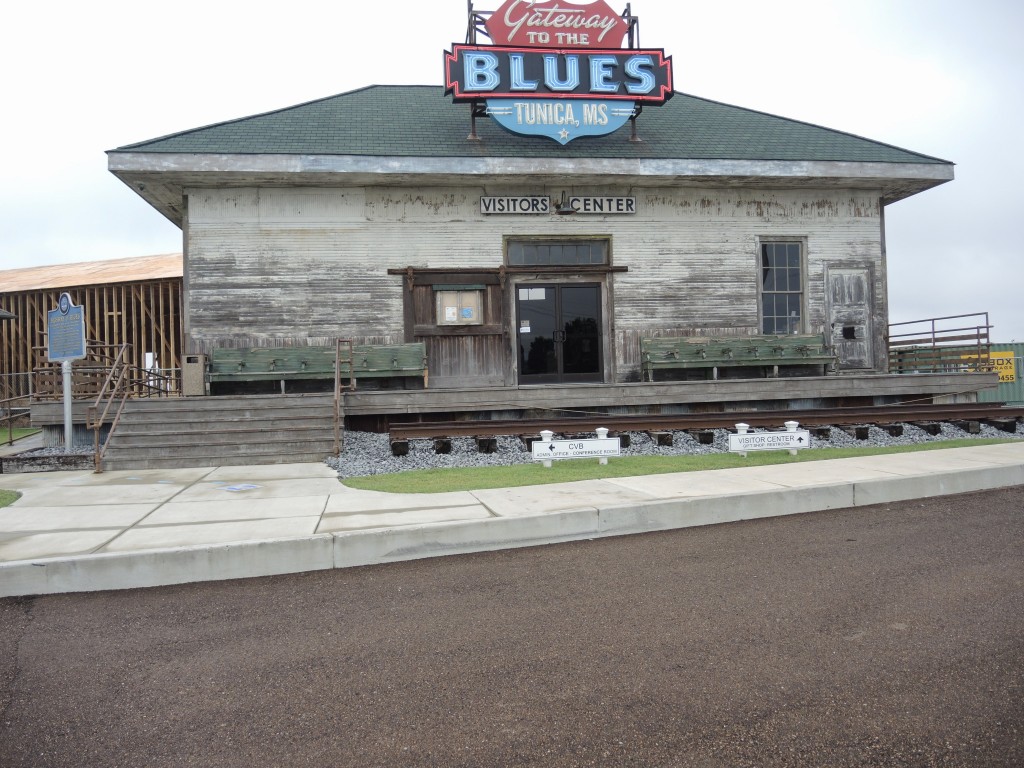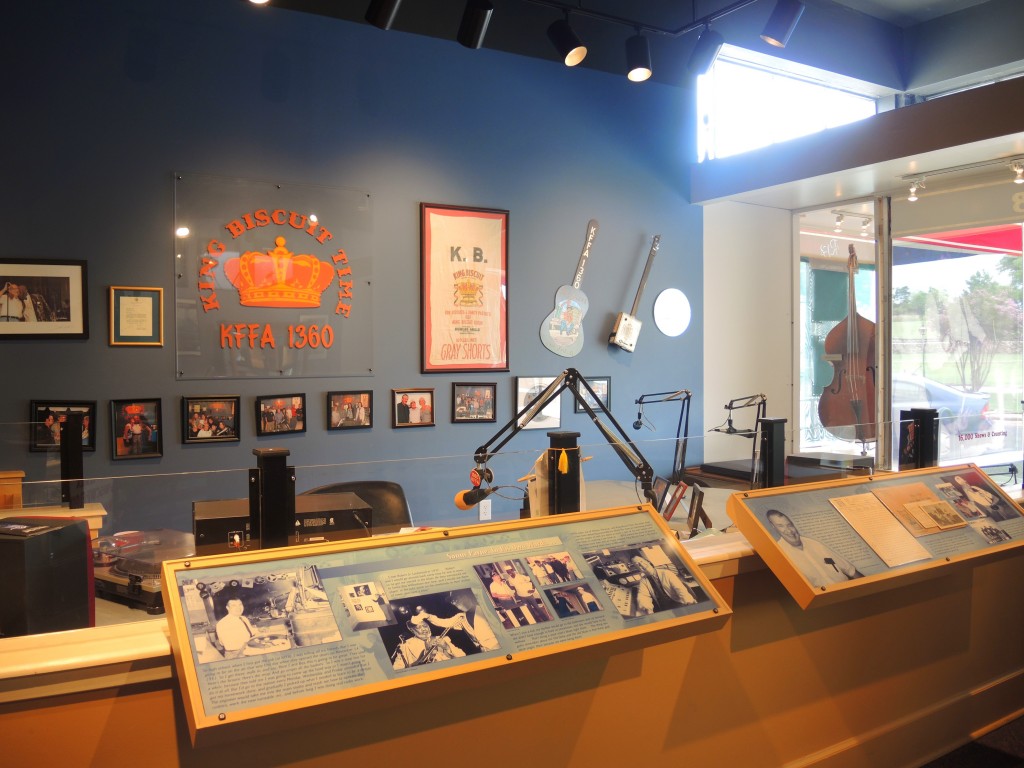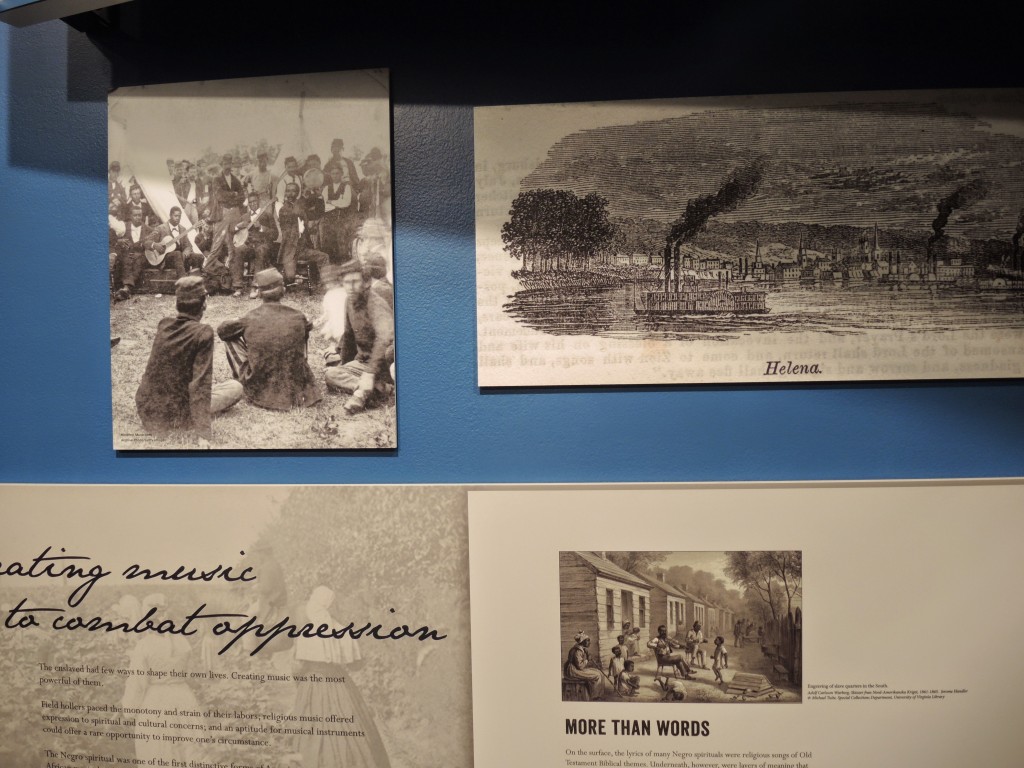Following my grumpy old man’s early night in Memphis, I was back on the road early Saturday morning. Driving south on Highway 61, I crossed into Mississippi in about 20 minutes. Your entry into that state becomes quickly apparent even without the “Welcome to Mississippi” road sign. As I would find along the gulf coast of the Magnolia State, the riverside in the northwest corner is peppered with casinos. Few of the casinos themselves are visible from Highway 61 but their entrances are – and those are many. Having no interest in this aspect of Mississippi culture, my first planned stop was Tunica where I expected to start the Blues Trail segment of the trip at the Gateway to the Blues Center located on Highway 61 in a nineteenth century train depot. As I understood it, this is still more a Visitors Center than a museum (though there are plans to add one) at this point in its development but my research indicated it was a reliable source of information and a good starting point for someone interested in chasing the blues. What I failed to learn, or perhaps simply overlooked, was that the center doesn’t open until 10:00 on Saturday so arriving at 09:15 was poor planning. I took some photos. I didn’t wait.
As I understood it, this is still more a Visitors Center than a museum (though there are plans to add one) at this point in its development but my research indicated it was a reliable source of information and a good starting point for someone interested in chasing the blues. What I failed to learn, or perhaps simply overlooked, was that the center doesn’t open until 10:00 on Saturday so arriving at 09:15 was poor planning. I took some photos. I didn’t wait.
One of the benefits of the casinos and the money they generate has been the creation of the Tunica Riverpark & Museum. (Once again, allow me a brief digression on the limitations of my GPS. According to the material I’d seen, the Riverpark is in Tunica. According to my GPS, and, had I double checked Google maps, it is in Robinsonville. Thus, the system couldn’t find the address when I input Tunica as the museum’s city.) The entrance to the Riverpark is adjacent to the Fitz Casino. In fact, until you bear left at the fork, the road to the casino and the park are one and the same. Once I arrived, I was treated to some splendid river views.

There are two hiking trails – the most intriguing of which is the Ecotrail which combines a boardwalk and a wilderness trail that meander over about three miles of Delta forest. Had I felt comfortable walking at a brisker pace than my knee pain allowed I likely would have covered this ground. However, as Harry Callahan would say, “A man’s gotta know his limitations.” And the truth is, I came to this part of Mississippi with the intent of chasing the blues. In my mind, I heard a voice holler, “No walk for you!”
The park also features the opportunity to take a 90-minute ride along the river on the Tunica Queen – a Mississippi steamboat. Though the idea of a steamboat ride had a certain quaint appeal, having experienced comparable chug, chug, chug, out and back rides on the Patapsco and Potomac rivers at home I concluded I could find a more personally rewarding way to spend an hour and a half. The voice returned. “No boat for you!”
I did spend some time in the Riverpark Museum and found the self-guided tour informative and interesting. The museum covers a wide range of subject matter from a history of the river to an overview of the region’s geology. There are also exhibit areas dealing with local fauna, early exploration and settlement, and even the delta blues. But no single exhibit overwhelms you with information so, all in all, it provided a pleasant and not too strenuous start to my Saturday morning. When you’ve seen enough of these exhibits, you can take an elevator to the third-floor observation deck that offers some more impressive river views. At ground level the overlooks that are built over the river provide another opportunity to get a more up close and personal with the river.
For my second stop on Saturday, I crossed the river to the small town of Helena, Arkansas. Helena is home to the Delta Cultural Center and this little town played an important role in, shall we say, spreading the gospel of the blues. On 21 November 1941, KFFA (1360 AM) in Helena aired the first broadcast of the King Biscuit Time radio show. Sonny Boy Williamson (who would later have his own show in Memphis) and Robert Lockwood, Jr. appeared live on the show after Sonny Boy and his band agreed to endorse the locally produced King Biscuit Flour. Still going strong, KBT aired its 17,000th show in May of this year making it the longest running show in radio history. The in-studio appearance by Williamson and Lockwood gave rise to a tradition of live performances that continues to this day. Visiting musicians often drop by and play with the house band – The King Biscuit Entertainers.
The in-studio appearance by Williamson and Lockwood gave rise to a tradition of live performances that continues to this day. Visiting musicians often drop by and play with the house band – The King Biscuit Entertainers.
In 1951, Sonny Payne assumed the position as the show’s permanent host and he still broadcasts live from the studio in the Delta Cultural Center every weekday. In 1992, the show won a Peabody Award for “for outstanding achievement in the field of radio and broadcast journalism through its continuous support of ‘an original American art form.'”
Then, in 1986, KBT sponsored the first King Biscuit Blues Festival. The three-day event was at one time the largest free blues festival in the south. Held every October on Columbus Day weekend, the festival now charges a nominal admission and is called by some the Arkansas Heritage and Music Festival. In another side note, many folks in the area believe that Sonny Payne and the KBT radio show served as the inspiration for the radio station where the Soggy Mountain Boys perform in the Coen Brothers movie O Brother Where Art Thou?
In addition to the many artifacts and the studio in the permanent Delta Sounds exhibit, there are panels that trace the relationship and rise of delta gospel and its influence on delta blues. This is exemplified by Sister Rosetta Tharpe who, in the 1930s, appeared in Carnegie Hall’s Spiritual to Swing Concerts. A performer more familiar to folks my age might be Al Green who was born in Forrest City, Arkansas about 40 miles northwest of Helena and who, after a successful R&B career, became a preacher for a time.
At the time of my visit, the center also had an exhibition on slavery and life before and immediately following the Civil War. It, too, had a musical component drawing a line tracing the evolution of the musical form from the call and response of field workers to gospel and then to the blues. However, in what I found to be a continuation of a rather dismaying and troublesome attitude, I thought the exhibit and the very genial guide tried to place a soft focus on the lens through which we viewed the inhuman and degrading reality of chattel slavery. 
I don’t relish confrontation and I’m even less inclined to embark on a discomforting course of conversation with strangers when on vacation. So, when this otherwise friendly and helpful man told me that plantation owners and overseers didn’t often whip their slaves because, “they were property and you want to preserve and protect your property not damage it,” I choked back my bile and said nothing. Even had I chosen to challenge him (and perhaps I should have), I don’t think it would have influenced him in any way because I sensed he sincerely believed his statement.
So, although the Delta Cultural Center Depot Museum which I might have otherwise visited, was only a block or two away, I politely thanked him and crossed back into Mississippi on the same bridge that had carried me across the river into Arkansas. Once back in that side of the river, I followed Highway 61 into Clarksdale. My immediate impression of that city was that much of the population there lives in poverty. Of course, having seen the conditions of life in a South African township, I realize that poverty is a relative matter. Still, for America, this looked like a poor community.
Note: In keeping with my 2022-2023 reformation of the blog into shorter entries, backdated to maintain their sequence, any comments on this post might pertain to its new configuration. See the explanation in the post Conventions and Conversions.
your description of the radio station in Arkansas makes me want to visit. sounds so very interesting. love your place at the Shack Up Inn!
Just go to KFFA on a weekday afternoon. They don’t broadcast from there on the weekend.
Mississippi….. is, I believe, general listed as the most impoverished state in the US. (It also has the distinction of having a variety of characteristics ususually listed in the bottom 5 of 10 of states. Things like: education, infant mortality, number of uninsured persons (health care), lowest results on reading and math scores…. and the like).
I’ve often wondered why this state consistently comes in on the bottom of such lists. If you have discovered answers during your research, please share.
The “cabin” was memorable….for sure.
Connie
I would like to say that I gained some insight on economic disparity but I have none.
Wow. The Tinth Shack at the Shack Up Inn appears unforgettable. What was the bed like? Did you rock in the chairs? How much does the Shack Up Inn charge per night for a Shack? Are the patrons mostly tourists or……locals?
The bed was a normal queen size bed. Mattress not overly firm. I did rock a bit but there are persistent mosquitoes and I don’t like to go to sleep doused in DEET. I paid $93 per night for my two night stay (this includes tax). Weekends require a minimum 2 night stay. The property is fairly spread out and you park on the grass or gravel nearest your shack so I didn’t not the state of origin on the license plates.